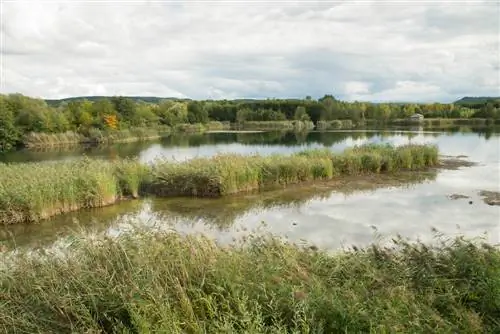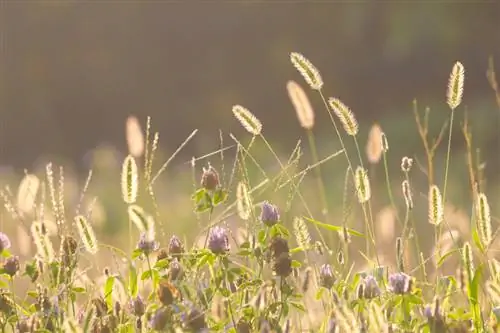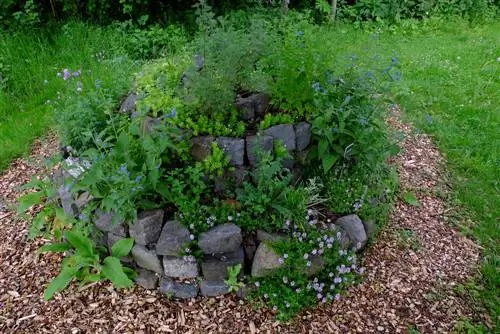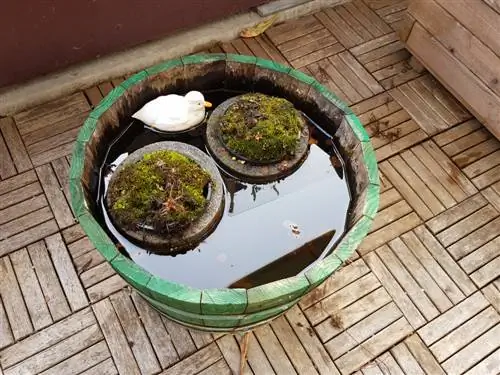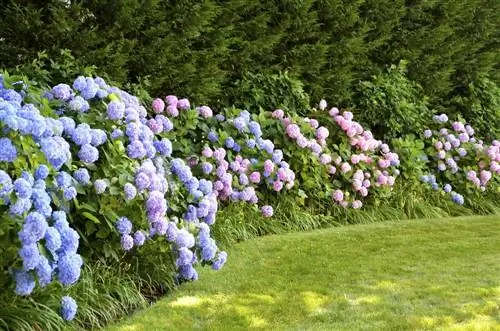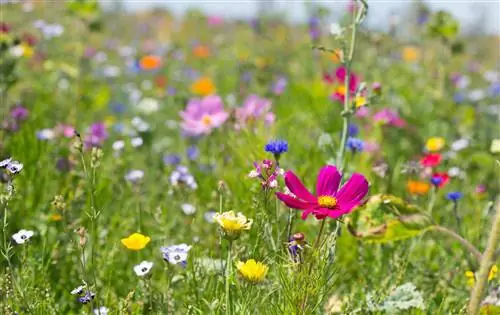- Author admin [email protected].
- Public 2023-12-26 14:17.
- Last modified 2025-06-01 06:02.
A refuge for flora and fauna - biotopes are important habitats, not just for rare plant and animal species. You can find out here how a biotope works and how you can design it yourself in the garden or in your room.
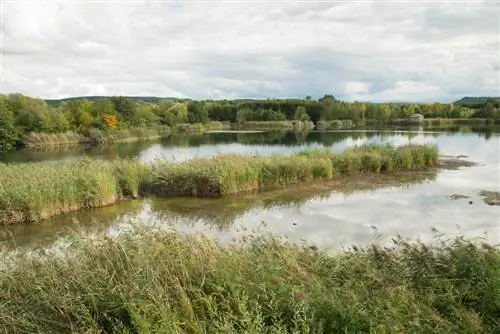
- various definitions of “biotope”, scientifically a definable habitat for certain plants and animals
- colloquially a refuge for rare species
- Biotopes can be created in the garden, even on the balcony or terrace
- You can create a biotope for your desk, an eternal bottle biotope in screw-top or swing-top jars
- Differentiation between different biotope types
What is a biotope? Definition and explanation
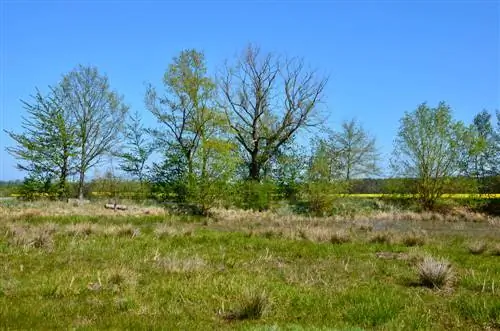
A biotope is literally a “place for life”
In biology, the term “biotope” refers to a specific, definable habitat within a larger area for plants and animals. The word is made up of the parts “bios” for life and “topos” for place, both of which come from the Greek language. A biotope is always alive because an area only becomes a biotope through its inhabitants.
In addition to the scientific term, the term also has another colloquial meaning. The word is also used for a small, newly created landscape area (for example in the garden) that serves as a habitat for rare animal and plant species. Under the heading “We are creating a biotope”, not only children are taught at school how to create a small garden pond with wet wasteland for frogs and other amphibians. In this context, “biotope” refers to the habitat of endangered species - and not all animal and plant species living there.
What is the difference between biotope, biocenosis and ecosystem?
This distinction is easy to explain:
- Biotope: means a specific habitat for animals and plants
- Biocenosis: is the community of organisms living in the biotope
There is no such thing as a biotope without a biocenosis; the two are inextricably linked. Together they form an ecosystem.
Examples of biotopes in nature
Within landscape management and nature conservation, biotopes are assigned to different biotope types that occur both naturally in nature and can be created artificially by humans. Examples of biotopes are:
- Wet biotope: Habitats such as moors and swamps, reed beds, mudflats and lagoon landscapes (on the coasts)
- Outdoor biotope: various meadows, such as dry and wet meadows, orchards, s alt marshes, flower meadows
- Forest biotope: floodplain forest, quarry forest, coniferous forest, swamp forest
- Water biotope: Distinction between still waters (ponds, ponds, ponds, lakes) and flowing waters (streams, rivers and river banks)
- Desert biotope: various desert landscapes, for example sand, stone, gravel or rocky deserts, s alt or ice deserts
Legally protected biotopes
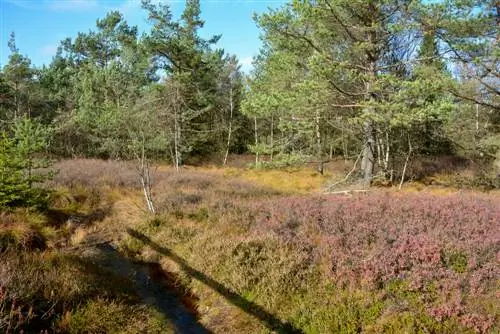
Moors are protected in Germany
According to Section 30 of the Federal Nature Conservation Act (BNatSchG), the following natural biotopes are under legal protection and may not be impaired:
- Inland waters including their bank areas, siltation areas, flood areas, oxbow lakes and vegetation
- Wet biotopes such as moors, swamps, wet meadows, spring areas, reedbeds and inland s alt marshes
- Inland dunes, dumps and heaths such as scree, rubble and block heaps, loess and clay walls, juniper, gorse and dwarf shrub heaths, heavy metal lawns, bristly grass and dry grass, forests and bushes in dry, warm locations
- Forests, especially floodplain, swamp and swamp forests, hillside rubble, log heap and ravine forests
- Rocky landscapes such as alpine lawns, Krummholz bushes, snow valleys and open rock formations
- Coastal biotopes such as steep and rocky coasts, beach ridges and coastal dunes, coastal lakes, tidal flats and s alt marshes, lagoon waters with silting areas, seagrass meadows, sand banks, reefs, shale, coarse sand and gravel areas
In the past, individual biotopes were primarily protected. However, this approach has proven to be of little help in terms of species protection, as most animal and plant species are mobile and also require exchange with other populations of their kind - keyword gene exchange and genetic impoverishment.
Since large-scale biotopes cannot be maintained due to the constraints of economic land use and settlement, the individual biotopes are connected to one another through various measures. This includes, for example, planting strips of bushes in fields for birds or building fish ladders so that aquatic animals can reach their spawning grounds. These biotope networks are also built within settlements (e.g. a green strip between two roads, toad tunnels) in order to make human living areas livable and traversable for animals and plants.
Excursus
That's why protecting natural biotopes is so important
Some people are critical of the protection of or a certain biotope because it could be used for agriculture or cultivated. The pressure - especially economic - to manage seemingly useless areas is great, especially since the costs of maintaining some biotopes are high.
But the preservation of habitats not only serves to protect animals and plants, but ultimately also us humans. The inevitable extinction of species also has a dramatic impact on us, which is why we urgently invest in landscape and nature conservation must prevent the urban sprawl of the landscape (for example by declaring more and more new building areas for private homes).
Creating a biotope in the garden
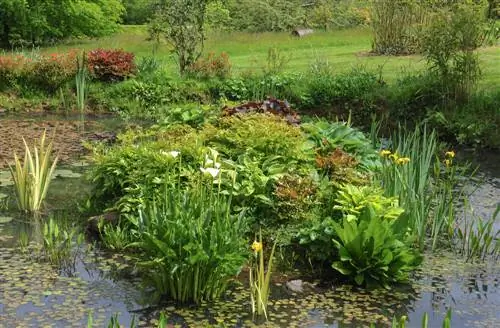
A garden pond creates a habitat for water-loving animals
Due to the decline in natural habitats due to intensive agriculture and urban sprawl, creating biotopes in the garden is even more important. This is generally understood to mean the construction of a garden pond, but the following habitats should not be neglected either:
- Garden pond: Minimum depth 60 centimeters, different zones (shallow water with stones, deep water), water and bank plants, habitat for frogs, newts and dragonflies, as well as drinking troughs for bees and others Insects, drinkers and bathing facilities for birds
- Deadwood: rotten tree stumps and trunks, deadwood hedge (“Benje hedge”), habitat for wild bees, beetles, nesting and hiding places for birds, hedgehogs and other species
- Pile of leaves and brushwood: Heap of autumn leaves and tree cuttings, valuable wintering quarters for hedgehogs, butterfly caterpillars, insects and mice
- Stone piles and dry stone walls: Heaps of large stones, roof tiles or building rubble, dry stone walls made of natural stone in sunny locations, suitable plants (e.g. cinnamon herb, stonecrop), habitat for wild bees, spiders and other insects, lizards
- Open sandy areas: simply leave a sandy area free and without plants, a home and nursery for soil-nesting bee species such as. B. Sand or furrow bee
- Stinging nettle corner: supposed weeds such as nettles, horn clover or wild carrot are valuable food plants for many butterfly caterpillars, which is why small corners in the garden with wild plants should be left
Just by piling up a pile of dead wood or setting up a Benje hedge and a small “weed corner” you create important retreat areas for many animals in the garden. Add a small garden pond and the natural garden is ready.
So that frogs, newts, hedgehogs, dragonflies etc. feel comfortable with you, you should definitely avoid using toxic chemicals. These primarily include plant protection products such as pesticides, fungicides, herbicides, but also artificial fertilizers. Close to nature (and therefore ecologically valuable) gardens are also not tidied up very accurately
Garden pond - a valuable biotope for newts, frogs and co
Creating a garden pond is actually very simple: you actually just have to dig a hole, seal it, add water and a few plants and you're done. The frogs and dragonflies find their way into the new wetland biotope all by themselves and in no time at all. To ensure that the wet biotope in the garden is a success, you should still follow a few tips.
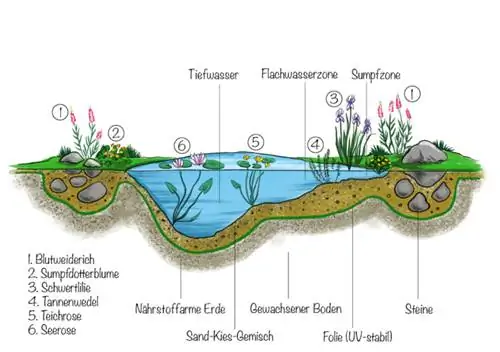
| Location | as flat a surface as possible, sunny and warm, two to three hours of shade per day |
|---|---|
| Riverside area | no abrupt end, but if possible a swamp area or wet meadow, suitable bushes (willow, buckthorn) |
| Pond Depth | at least three water depths, at least 60 centimeters deep in the middle, gradually leveling off as you get closer to the shore |
| Planting | Water lilies in the middle, native aquatic plants in the other areas |
| Transitions / gradients | no more than 50 percent, gentle and flowing, otherwise no soil can hold |
Before creating the garden pond, think carefully about what shape it should have and where the various bank areas will ultimately be located. Mark these and dig the hole accordingly. Then seal it so that the water stays in the garden pond and does not seep into the ground. You have three options:
- Clay: natural material, clay layers should be at least 30 centimeters thick and well tamped
- Concrete: practically indestructible, very durable and long-lasting, but also difficult to remove, thickness should be at least 20 centimeters, stabilization with structural steel mesh is necessary
- Film: very malleable and easy to lay, inexpensive - but made of plastic, if possible, prefer products made of plasticizer-free and more environmentally friendly polyethylene
You can also simply install a prefabricated pond made of hard plastic, which is quick and easy. However, finished pond shells in large sizes cost several thousand euros, which is why you can get away with a different solution much cheaper and invest the money saved in beautiful pond and bank plants. However, if the garden pond is to be small, ready-made hard shells are an uncomplicated choice.
Now you can start planting. Tip: If you have pond owners in the neighborhood, ask for cuttings of aquatic plants. Hornleaf, rushes, sea cans, duckweed and the like are very proliferative, which is why many pond owners are happy to get rid of one or two plants.
If there is no space for a large garden pond - mini pond in the tub
If you only have a small garden or don't want a large pond on your property - for example because you have small children - you can also create a small biotope with a mini pond. All you need is a container, such as an old (bath) tub, a barrel or something similar. You can bury this and add some water and bank plants, and your tiny insect paradise is ready.
Benje hedge - How to create a deadwood hedge

A deadwood or Benje hedge consists of loosely stacked branches and twigs that are fastened between posts inserted into the ground. The entire scaffolding forms a stable wall, which can also be used very well as a property boundary and/or privacy screen. Deadwood hedges are anything but dead, because over time they develop a diverse life of their own. They offer many animals such as hedgehogs, dormice, blackbirds and other birds (wrens, robins), sand lizards and common toads a welcome shelter in summer and winter.
In addition, through the arrival of plant seeds or through your plantings, live plants will soon grow, turning the dead wall into a living hedge. When planting the Benje hedge you should pay attention to these points:
- choose a sunny, warm and quiet location
- Soil should not be too nutrient-rich
- otherwise nettles and other overgrown plants will settle
- no pruning of strongly dominant trees, e.g. E.g. blackberries, use
- Use hardwood instead (beech, oak, fruit tree cuttings)
- stack these loosely between poles dug parallel into the ground
- large branches downwards, finer clippings upwards
- Weave in posts if possible
- plant slow-growing shrubs as a companion
Colorful meadow instead of green lawn
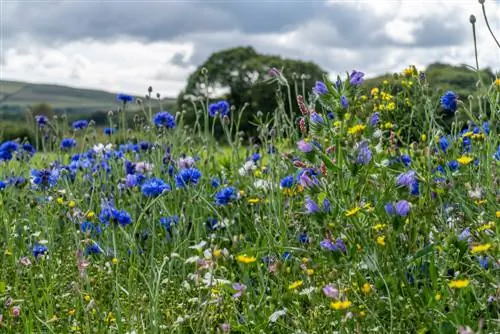
Colorful meadows provide a home for numerous insects
Most gardens have a more or less large lawn area. Did you know that lawns are basically just a green wasteland? For insects such as bees, butterflies and beetles, the blades of grass are worthless because they do not provide any food. However, it is better to sow a colorful wildflower meadow - not only is it much less work than a lawn, but it also looks beautiful and offers a valuable habitat for many small creatures.
Creating a flower meadow is very easy:
- Prepare the soil: Remove the turf, loosen the soil and enrich it with sand, wildflowers need a rather poor soil
- Sowing seeds: Spread the finished wildflower mixture on the prepared area, plan around five to ten grams of seeds per square meter of meadow, then rake in and secure with a roller or board, for at least keep moist for four weeks
- Care of the meadow: mow twice a year, at the end of June and the end of August
When choosing flowers, give preference to native species, as hungry insects can do more with them. Particularly recommended are:
- Meadowsweet (Filipendula ulmaria)
- Daisies (Bellis perennis)
- Common Yarrow (Achillea millefolium)
- Hollow Larkspur (Corydalis cava)
- Horn trefoil (Lotus corniculatus)
- Common poppy (Papaver rhoeas)
- Cornflower (Centaurea cyanus)
- Creeping Gunsel (Ajuga reptans)
- Calflight (Silene noctiflora)
- Carnation (Silene latifolia)
- Marguerite (Leucanthemum vulgare and ircutianum)
- Snakehead (Echium vulgare)
- Red clover (Trifolium pratense)
- Soapwort (Saponaria officinalis)
- Meadow Foxtail (Alopecurus pratensis)
- Meadow bellflower (Centaurea jacea)
- Meadow sorrel (Rumex acetosa)
- Meadow Scabious (Knautia arvensis)
- Wild teasel (Dipsacus fullonum)
- Wild carrot (Daucus carota)
Wildflower meadows should be sown in June at the latest. To ensure that bees, bumblebees, etc. find enough flowers in spring, plant additional flower bulbs, such as wild garlic (Allium ursinum), wood anemone (Anemone nemorosa), yellow wood anemone (Anemone ranunculoides), hollow larch spur (Corydalis cava) and winter aconite (Eranthis hyemalis).
Biotope on the balcony - how does it work?

You don't need a large garden to create a biotope for bees, bumblebees, butterflies and other insects - a small balcony is enough. Here you have many opportunities to make the buzzing people comfortable and provide them with food. And this is how it works:
- choose nectar- and pollen-rich summer flowers and climbing plants
- Herbs such as sage, lavender, lemon balm or thyme are particularly popular with humans and animals
- Nasturtium is very suitable for the balcony, is a great source of nectar
- Butterfly lilac (Buddleja) can also be kept in a pot
- Provide hatching opportunities for wild bees
- don't worry, these species live solitary lives (i.e. alone) and are not interested in people
- take thick pieces of oak or beech wood and drill three to eight millimeter narrow, blind-ended holes in them
- other wild bee species prefer perforated bricks filled with clay
- Create a mini pond
By the way, many songbirds also like to breed on balconies if they have the opportunity to do so. Offer the animals a place to feed in winter (e.g. in a bird feeder), but make sure that pigeons, crows and other large birds do not have access - this is forbidden. Maybe one or two squirrels will come along looking for food. In spring you can offer a nesting box and see if there is a resident.
Excursus
Carefully select plants for a biotope
Furthermore, it is important to avoid overly cultivated plants, as these - such as noble roses with double flowers - have no value for bees and other insects. Instead, choose flowers, perennials and trees with ecological added value because they provide nectar and pollen for insects and fruit for birds. Umbelliferous plants and native flowering shrubs are particularly important here.
Create a mini biotope in a glass

A mini biotope in a glass is easy to make yourself
An eternal glass or bottle biotope is - ideally - a self-contained ecological cycle that requires no maintenance at all. Everything the plants need comes back to them here - evaporated water condenses and creates a small water cycle, and the nutrients are also retained. And this is how you create the mini garden for your desk:
- a large swing-top or screw-top jar made of clear glass
- Capacity at least two or three liters
- Plant granules or small pebbles as drainage
- suitable plants such as blueberries or cranberries, heather or small ferns
- Soil from where the plants grew
- Decorative elements (e.g. a pretty stone, a small branch)
It is now important that all ingredients are free of mold. Otherwise, the everlasting garden will quickly begin to mold. You should therefore disinfect the glass as well as the stones and soil before filling, for example by boiling or heating. How to plant the glass:
- approx. Fill in a two centimeter thick drainage layer
- on top of that the layer of earth about four to five centimeters thick
- press small hollows in the earth
- Insert the plants using tweezers
- press well
- Insert decorative elements such as pieces of moss, stones and twigs
- don't touch the glass wall
- Watering the bottle garden
- Close the lid
Now place the mini biotope in a bright, but not directly sunny place. Ideally, the inside of the glass should be foggy with condensation in the morning, but dry throughout the day. If the glass walls are wet all day, open the lid for a few days and let the excess water evaporate.
Frequently asked questions
Are a nature reserve and a biotope the same thing?
No, nature reserves and legally protected biotopes refer to two different forms of protected areas, even if they usually overlap. Protected biotopes are often located in a nature reserve, as is the case in the Western Pomerania Lagoon Landscape National Park or the Wadden Sea National Park. As a rule, nature reserves are larger than the rather small biotopes.
Tip
By the way, a biotope can be created not only in screw-top jars or bottles, but also in an aquarium. Here you can create a real little ecosystem.

